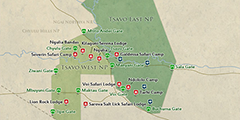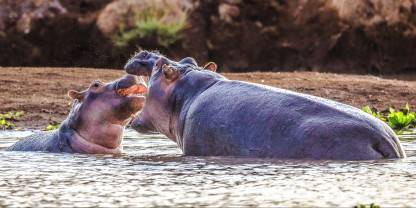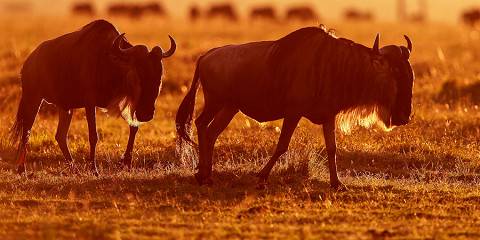Tsavo West National Park divides opinion among travelers. Some love its superb scenery and sometimes-fantastic wildlife, others find it a little frustrating when it comes to seeing animals. They’re both right: the park is home to the , but wildlife viewing can be a bit slow. Highlights include recent lava flows and lush Mzima Springs with its close-up views of .

-
Best Time To Go
- June to October and January to February (Best for general wildlife viewing; little rainfall)
-
High Season
- December to March and July to October (Busy)
-
Size
- 7,065km² / 2,728mi²
-
Altitude
-
419-1,677m /1,375-5,502ft
 View Photos
View Photos
 View Photos
+24
Photos
View Photos
+24
Photos
 Open Map
Open Map
Pros & Cons
- Great wilderness destination
- Wide variety of animals, including all the
- Excellent birding with some dry-country specials
- A chance of seeing the rare in Ngulia Rhino Sanctuary
- Short walking trail, resident and underwater at Mzima Springs
- Wildlife densities are rather low
- Seeing wildlife can be unpredictable due to dense vegetation
Wildlife
Tsavo West is a real wilderness destination. All of the are present in the park. Sightings of lion, leopard, buffalo and elephant are possible in the main area. There is a good chance of seeing in Ngulia Rhino Sanctuary, especially from the viewing platform. Elephant herds can be found gathered at the . However, wildlife densities are lower than in some of Kenya’s more popular parks. There is a good variety of animals though, including many dry-country specials such as the shy and the rare .
More about Tsavo West’s wildlifeScenery
Tsavo West has a rugged, arid beauty with varied landscapes that include dense woodlands, rocky outcrops, volcanic hills, the Shetani lava flows and Chaimu Crater. The jagged Ngulia Hills run like a spine through the park. Underpinning everything is black volcanic soil and Tsavo’s famous red dust. A small number of rivers (most seasonal, some year-round) meander through the park, but Mzima Springs is like a verdant oasis. Lake Jipe, south of the Taveta Road, has a very different feel to the rest of the park.
Activities
Like most Kenyan parks, the main activities in Tsavo West are guided , where you can look for wildlife and enjoy bird watching. Apart from within the grounds of your accommodations, the only places where you’re allowed outside your vehicle are Mzima Springs (where there is a short, pretty walking track through the fever tree forest) and Chaimu Crater.
Weather & Climate
Like its sister park to the east, Tsavo West is a hot and dry place, even if temperatures drop significantly at night. The best place to escape the heat is the higher altitudes of the park, where it cools by 6.5°C/3.5°F for every 1,000m/1,000ft you climb. The Dry season (June to October) is characterized by bright, sunny days, and the Wet season (November to May) by afternoon showers.
More about the weather and climateBest Time To Visit
If you prefer lush green vegetation and want a clear view of Mt Kilimanjaro, you should visit in the Wet season (November to May). also offer a great spectacle at this time. But for wildlife viewing in general, you should visit in the drier months (June to October and January to February), when a lack of water sees animals gather at local rivers and .
More about the best time to visit



